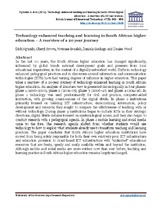| dc.contributor.author | Ng’ambi, Dick | |
| dc.contributor.author | Brown, Cheryl | |
| dc.contributor.author | Bozalek, Vivienne | |
| dc.contributor.author | Gachago, Daniela | |
| dc.contributor.author | Wood, Denise | |
| dc.date.accessioned | 2018-07-12T10:00:26Z | |
| dc.date.available | 2018-07-12T10:00:26Z | |
| dc.date.issued | 2016 | |
| dc.identifier.citation | Ng’ambi, D. et al. (2016). Technology enhanced teaching and learning in South African higher education – A rearview of a 20 year journey. British Journal of Educational Technology, 47(5): 843 – 858. | en_US |
| dc.identifier.issn | 0007-1013 | |
| dc.identifier.uri | http://dx.doi.org/10.1111/bjet.12485 | |
| dc.identifier.uri | http://hdl.handle.net/10566/3877 | |
| dc.description.abstract | In the last 20 years, the South African higher education has changed significantly, influenced by global trends national development goals and pressure from local educational imperatives, in the context of a digitally networked world. Shifts in technology enhanced pedagogical practices and in discourses around information and communication technologies (ICTs) have had varying degrees of influence in higher education. This paper takes a rearview of a 20-year journey of technology enhanced learning in South African higher education. An analysis of literature view is presented chronologically in four phases: phase 1 (1996–2000), phase 2 (2001–05), phase 3 (2006–10) and phase 4 (2011–16). In phase 1 technology was used predominantly for drill and practice, computer-aided instruction, with growing consciousness of the digital divide. In phase 2 institutions primarily focused on building ICT infrastructure, democratizing information, policy development and research; they sought to compare the effectiveness of teaching with or without technology. During phase 3 institutions began to include ICTs in their strategic directions, digital divide debates focused on epistemological access, and they also began to conduct research with a pedagogical agenda. In phase 4 mobile learning and social media came to the fore. The research agenda shifted from whether students would use technology to how to exploit what students already use to transform teaching and learning practices. The paper concludes that South Africa’s higher education institutions have moved from being solely responsible for both their own relatively poor ICT infrastructure and education provision to cloud-based ICT infrastructure with “unlimited” educational resources that are freely, openly and easily available within and beyond the institution. Although mobile and social media are more evident now than ever before, teaching and learning practice in South African higher education remains largely unchanged. | en_US |
| dc.language.iso | en | en_US |
| dc.publisher | Wiley | en_US |
| dc.rights | This is the author-version of the article published online at: http://dx.doi.org/10.1111/bjet.12485 | |
| dc.subject | Teaching and learning | en_US |
| dc.subject | South Africa | en_US |
| dc.subject | Higher education | en_US |
| dc.subject | Technology enhanced learning | en_US |
| dc.subject | e-Pedagogy | |
| dc.title | Technology enhanced teaching and learning in South African higher education – A rearview of a 20 year journey | en_US |
| dc.type | Article | en_US |
| dc.privacy.showsubmitter | FALSE | |
| dc.status.ispeerreviewed | TRUE | |
| dc.description.accreditation | ISI | |

